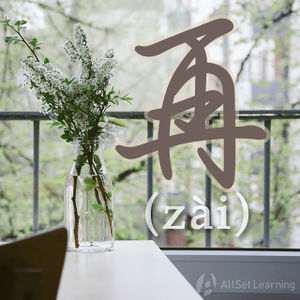Difference between revisions of "Sequencing with "xian" and "zai""
| Line 11: | Line 11: | ||
<div class="jiegou"> | <div class="jiegou"> | ||
| − | 先 + [ | + | 先 + [Verb Phrase 1] + 再 + [Verb Phrase 2] |
</div> | </div> | ||
Revision as of 09:25, 22 November 2016
-
Level
-
Similar to
-
Used for
-
Keywords
The word 再 (zài) actually has a lot of uses, beyond just "again." "先⋯⋯, 再⋯⋯" (xiān..., zài...) is a pattern used for sequencing events, much like "First..., then..." in English. This pattern can also include "然后" (ránhòu) meaning "and after that."
Contents
General Usage of 先⋯⋯再⋯⋯
In the pattern below, 再 has a meaning of "then" or "and then."
Structure
先 + [Verb Phrase 1] + 再 + [Verb Phrase 2]
Examples
- 我 会 先 洗 手,再 吃 晚饭。I'll first wash my hands, then eat dinner.
- 她 要 先 吃 早饭,再 去 学校。First she's going to eat breakfast, then she'll go to school.
- 我 喜欢 先 洗澡,再 睡觉。I prefer to take a bath before I go to bed.
Using 再说
You may have learned that "再说" can mean "in addition." Well, this usage of 再 is a more literal combination of 再 + 说, fitting into the 先⋯⋯再⋯⋯ pattern.
So in this usage, 再说 doesn't really mean "in addition." Rather, it most literally means "and then we'll talk." In other words, "let's just do this now," and then after we see the result, we can talk some more about next steps. There's kind of a "let's see how this goes first" feeling to the expression.
Structure
Note that in the pattern below, the sentence normally ends with 再说.
先 + [Event 1] + 再说
Examples
- 先 吃饭 再说 。Let's eat first, then we'll talk.
- 先让 他 把 工作 做完再说 。Let him finish his work first, and then we'll talk.
- 我 先 跟我 父母 商量一下再说 。I'm going to talk to my parents first, then we can talk.
- 我们 先 休息 一下 再说 。Let's rest a little first, then talk.
- 你们 先 讨论 一下 再说 。You guys discuss a little first, then we'll talk.
Sources and further reading
Books
- Integrated Chinese: Level 1, Part 1 (3rd ed) (pp. 258-9) →buy
- Integrated Chinese: Level 2, Part 2 (pp. 19-20) →buy
- 卓越汉语-公司实战篇 (p. 172) →buy



